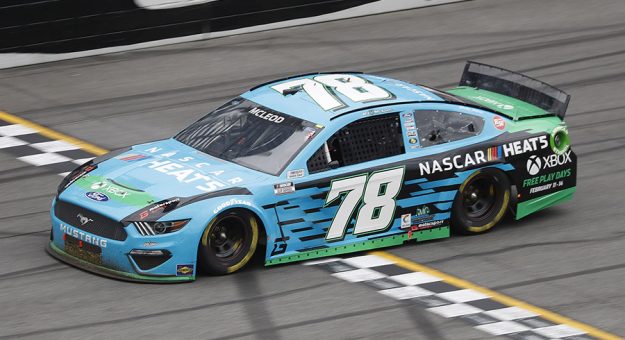Editor’s Note: This is the second in a series of stories about NASCAR’s Next Gen race cars and how teams are preparing for the introduction of the newest evolution of NASCAR stock cars.
For at least one more week, the club of active NASCAR Cup drivers who also own a Cup Series team has a membership of two: Denny Hamlin and B.J. McLeod.
On one end of the garage, Hamlin’s first-year team 23XI Racing has a partnership with Joe Gibbs Racing, unlimited resources and NBA legend Michael Jordan as a co-owner.
On the other end of the garage is McLeod’s first-year team Live Fast Motorsports.
Live Fast Motorsports has nine employees and former Cup driver Matt Tifft as a co-owner.
Fielding the No. 78 Ford in 2021, aside from McLeod’s ninth-place finish in the regular-season finale at Daytona Int’l Speedway, the team has finished in the top-25 three other times.
When McLeod hears the words “Next Gen Car,” what comes to mind?
“Opportunity, it’s that simple,” McLeod told SPEED SPORT prior to the Cup Series playoff race at Kansas Speedway.
“It makes the box a lot smaller that we have to figure out to improve our program,” McLeod continued. “We’ll have the same transaxle that the top-five teams have. We’ll have the same steering rack, the same spindles, hubs, … the majority of the car, we will have a top five piece of equipment, just that simple.”
Having the same equipment as teams like 23XI Racing is one thing. Having the resources and infrastructure to get everything out of that equipment is another.
McLeod, who has made 83 Cup starts since 2015, doesn’t have any illusions about what Live Fast Motorsports can do in the first year of the Next Gen era.
“There’s still a lot of engineering that goes into it and a lot of work,” McLeod said. “Having great people and a budget is still going to be a big deal. But this will help close us up to that front part of the pack a lot easier than it would have been we’d never had that come along.
“Let’s say we had Gen six for the next 20 years, we would have definitely worked hard to try to get to that next level just like Furniture Row (Racing). Front Row (Motorsports) has done well, they won the (Daytona) 500 this year. People that started out small and got big. And there was even a time that (Stewart) Haas was a beginner, right? We definitely would have worked with that. But this car is gonna speed up that curve a lot for us.
“We still have a lot of a lot of things to overcome, and we have to work, get our budgets larger to be quicker, but the first thing that comes to mind is opportunity to be better, quicker.”
What hurdles remain in place for Live Fast going forward?
Aero and engine power.
“There’s no supplement in that the aero part of that car there’ll always be smart people figuring out things to get advantages,” McLeod said. “But the advantages will be far smaller in proportion with the Next Gen car as they are in a Gen 6 car. And aero is one of the places we suffer most with the Gen 6 car. It’s unreal how temperamental these cars are, like bending a fender.
“I think one of Toyota’s got left-rear damage at Michigan. And I passed him, before the end of the first stage. And it was somebody that usually has got me eight-laps down. They fixed the quarter panel, and then he lapped me five times before the end of the race. So it’s that much of a difference that we’re behind on the aero side right now.”
In 34 races in 2021, the No. 78 Ford has failed to finish four. Of the remaining 30, Live Fast Motorsports has finished on the lead lap just seven times. Those were all on superspeedways and road courses.
McLeod noted his team is “still looking to be a 30th-place team” when 2022 starts.
This is where McLeod’s version of “opportunity” is different from other team’s. The kind of opportunity that could be good for driver and team morale.
“We’re looking to be a 30th-place team, half the amount of laps down that we are right now on a mile-and-a-half track,” McLeod said. “Some of the short tracks, we finished two, three laps down. We’re not so far out … On a mile-and-a-half, we get beat really, really bad.”
For McLeod personally, he hates “being eight, nine laps down at the end of a race (at a 1.5-mile track). It just really does beat you down week after week after week.”
With the Next Gen car, McLeod believes “that without a doubt, we’ll cut 50 percent of that out because of the box we’ve been put in with this Next Gen car from front to back of the field.
“And that is the biggest cost savings is the money we would have had to take to develop our team to that level. It just got erased.”
Where does McLeod envision Live Fast Motorsports diverting the cost savings that won’t be going toward development?
Infrastructure.
By 2023, McLeod hopes to have an engine lease program.
“Right now, we still own our own engines,” McLeod said. “And that is a pretty significant difference for the series.”
Speaking of morale and infrastructure, with the transition to the Next Gen car, teams like JTG Daugherty Racing will be cutting back on employees, especially in departments that are now unnecessary.
Live Fast Motorsports actually expects to increase its numbers, from nine to between 12 and 15.
